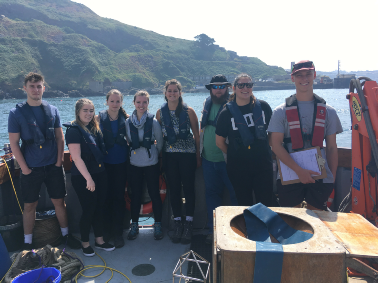
PLYMOUTH 2018

REFERENCES
HOME PAGE
1] Tattersall, G., Elliott, A. and Lynn, N. (2002). Suspended Sediment Transport
In The Tamar Estuary. [online] Cefas.co.uk. Available at: https://www.cefas.co.uk/publications/posters/29363.pdf#
[Accessed 6 Jul. 2018]
[2] Gosling, S., Lewis, E., Birkinshaw, S., Tratalos, J.
and Haines-Young, R. (n.d.). The effects of future land-cover change on UK river
flows. [online] Uknea.unep-wcmc.org. Available at:
[3] Designatedsites.naturalengland.org.uk.
(n.d.). Natural England Conservation Advice for Marine Protected Areas Plymouth Sound
and Estuaries SAC. [online] Available at: https://designatedsites.naturalengland.org.uk/Marine/MarineSiteDetail.aspx?SiteCode=UK0013111&SiteName=&countyCode=&responsiblePerson=&S eaArea=&IFCAArea=
[Accessed 6 Jul. 2018].
[4] Ukmarinesac.org.uk. (n.d.). Plymouth Sound and Estuaries
European marine site: Case History. [online] Available at: http://www.ukmarinesac.org.uk/pdfs/casestudy-plymouth.pdf
[Accessed 6 Jul. 2018].
[5] Inset map (Figure 1) available at: http://jncc.defra.gov.uk/protectedsites/sacselection/sac.asp?EUCode=UK0013111
[6]
Main map (Figure 2) available at: http://www.soes.soton.ac.uk/teaching/courses/soes3018/2005/group12/Group12sitejazz.htm
OFFSHORE
[1] Google Earth
[2] Strickland, J. and Parsons,T. (1977). A practical handbook
of seawater analysis. Ottawa: [Queen's Printer].
[3] Google Earth
[4] with
stronger tidal influence causing a more well-established front [4] (Plymouth, 2012)
[5]
Painter et al., 2016
[6] Hutchings et al., 1995
[7] Throndsen J., (1978)
Preservation and storage. In: Sournia A (ed) Phytoplankton manual. UNESCO, Paris,
p 69–74
[8] Widdicombe C et al., (2010) Long-term phytoplankton community dynamics
in the Western English Channel. Journal of Plankton Research, 32(5), 643
ESTUARY
[1] Viaroli, P., Nizzoli, D., Pinardi, M., Rossetti, G. and Bartoli, M. (2018). Factors Affecting Dissolved Silica
Concentrations, and DSi and DIN Stoichiometry in a Human Impacted Watershed (Po
River, Italy). [online] Available at: https://link.springer.com/content/pdf/10.1007%2Fs12633-012-9137-8.pdf
[2]
Morris, A., Bale, A. and Howland, R. (1981). Nutrient distributions in an estuary:
Evidence of chemical precipitation of dissolved silicate and phosphate. Estuarine,
Coastal and Shelf Science, 12(2), pp.205-216.
[3] Morris, A., Howland, R., Woodward, E., Bale, A. and Mantoura, R. (1985). Nitrite
and ammonia in the Tamar estuary. Netherlands Journal of Sea Research, 19(3-4), pp.217-222.
[4] Lyons,
W., Neilson, B. and Cronin, L. (1982). Estuaries and Nutrients. Estuaries, 5(4),
pp.239-250.
[5] Lyons, W., Neilson, B. and Cronin, L. (1982). Estuaries and Nutrients. Estuaries,
5(4), pp.239-250.
[6] Tidetimes.org.uk. (2018). Plymouth (Devonport) Tide Times
| Tide Times. [online] Available at: https://www.tidetimes.org.uk/plymouth-devonport-tide-times-20180705
[Accessed 10 Jul. 2018].
[7] Timeanddate.com (2018). Past weather in Plymouth, England, United Kingdom – yesterday or further back. [online] Available at: https://www.timeanddate.com/weather/uk/plymouth/historic
[8] Throndsen J., (1978) Preservation and storage. In: Sournia A (ed) Phytoplankton manual. UNESCO, Paris, p 69–74
[9] Wang, Y et al. (2014) Phosphorus, Nitrogen and Chlorophyll-a are significant
factors controlling ciliate communities in summer in the Northern Beibu Gulf South
China sea. PLOS ONE 9(7)
[10] Strickland, J. and Parsons,T. (1977). A practical
handbook of seawater analysis. Ottawa: [Queen's Printer].
[11] Baldwin, S. (n.d.).
A Preliminary Investigation on Turbidity and Chlorophyll-a patchiness in Lake Tanganyika,
Kigoma Bay. [online] Geo.arizona.edu. Available at: https://www.geo.arizona.edu/nyanza/pdf/Baldwin.pdf
[Accessed 9 Jul. 2018].
[12] Envirothon.org. (n.d.). Material for Estuaries. [online]
Available at: http://www.envirothon.org/pdf/2011/materials_for_estuaries.pdf [Accessed
9 Jul. 2018].
GEOPHYSICS
[1] Stæhr, P., Pedersen, M., Thomsen, M., Wernberg, T. and Krause-Jensen, D. (2000).
Invasion of Sargassum muticum in Limfjorden (Denmark) and its possible impact on
the indigenous macroalgal community. Marine Ecology Progress Series, 207, pp.79-88.
[2] Lazzari,
M., Sherman, S. and Kanwit, J. (2003). Nursery use of shallow habitats by epibenthic
fishes in Maine nearshore waters. Estuarine, Coastal and Shelf Science, 56(1), pp.73-84.
[3] Leclerc,
J., Riera, P., Lévêque, L. and Davoult, D. (2016). Contrasting temporal variation
in habitat complexity and species abundance distributions in four kelp forest strata. Hydrobiologia,
777(1), pp.33-54.
[4] Posford Duvivier Environment (1997). Broad scale biological
mapping of Plymouth Sound and Estuaries. English Nature Research Report No. 208.
Peterborough: Engloóidh Nature, pp.1-11, 16.
[5] A Curtis, L. (2013). Plymouth Sound
and Estuaries SAC Seagrass Condition Assessment 2012. Plymouth Sound and Estuaries
SAC Seagrass Condition Assessment 2012. Report Number: ER12-185. Devon: Natural England.
[6] Ware,
S. and Meadows, B. (2012). Monitoring of Plymouth Sound and Estuaries SAC 2011. onitoring
of Plymouth Sound and Estuaries SAC 2011. Final Report (C5521). Suffolk: Cefas.
REFERENCES
| Our Findings Home |
| Offshore |
| Estuary |
| Geophysics |
| C1 |
| C2/3 |
| C4 |
| C5 |
| C6 |
| C7 |
| Falcon Spirit |
| Winnie the Pooh |
| Pontoon |